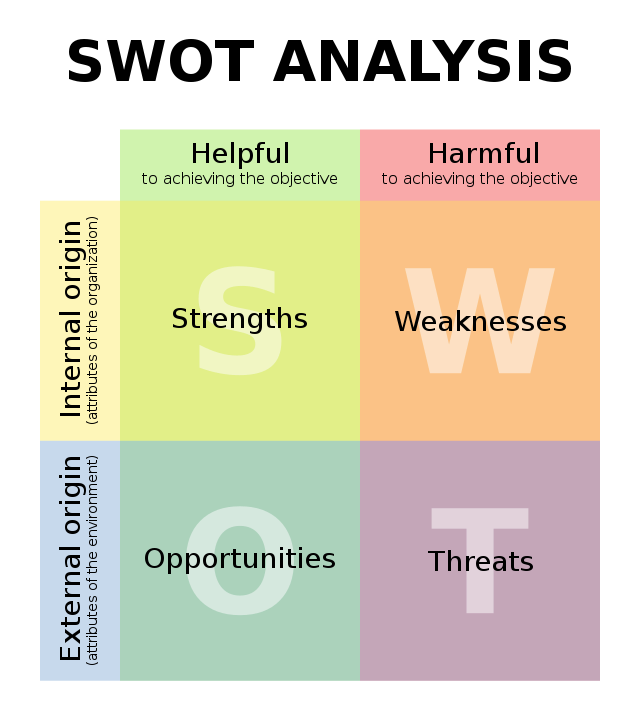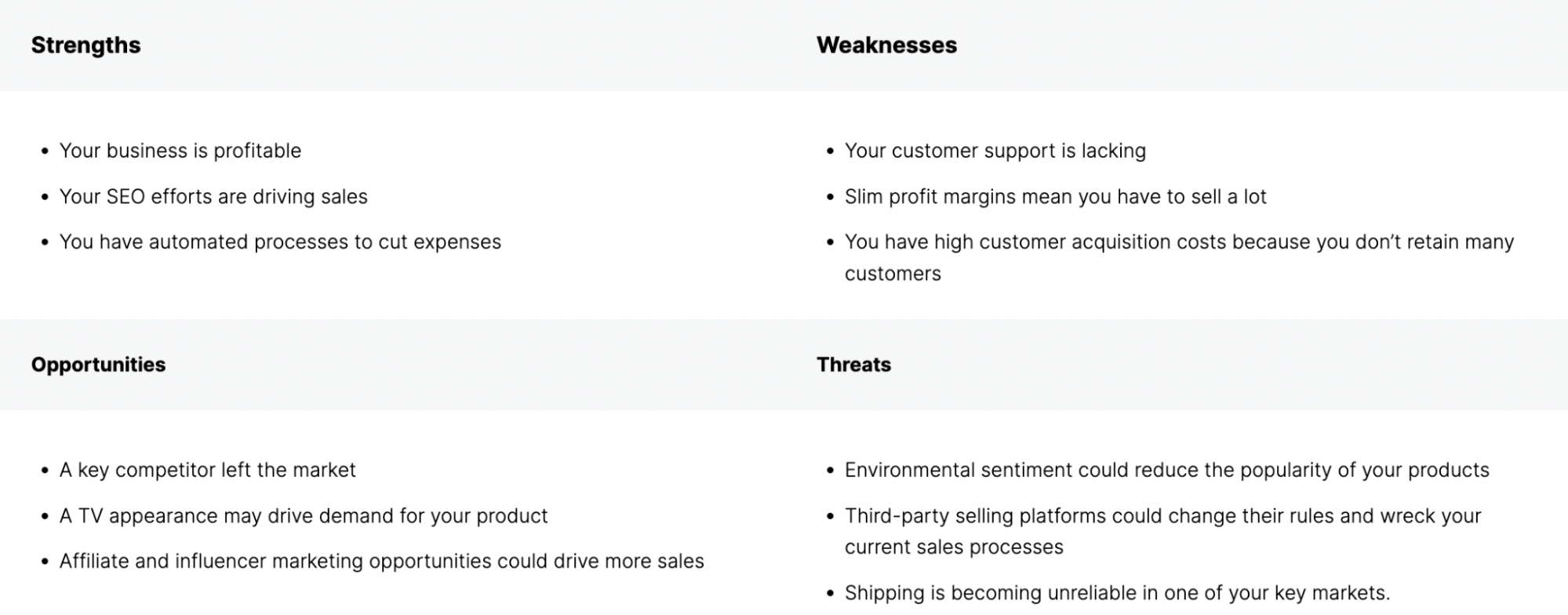SWOT Analysis in SEO
SWOT Analysis is a fundamental strategic planning technique used to identify the strengths, weaknesses, threats, and opportunities of a project, process, method, or company. By definition, SWOT is designed to help identify the items with the greatest potential impact on growth or the most dangerous threats. This analysis offers a powerful and creative approach to our SEO work and planning, where we can make sense of where we are positioned relative to the internal and external environment, or "where we are going".
The primary purpose of a SWOT analysis is to help organizations develop a full awareness of all factors when making a business decision or planning. You can make a list of what to focus on in the medium and long term when creating your SEO strategies.

SWOT Analysis is an acronym for the four components that the technique examines:
- Strengths: The strengths of the project, and the internal factors that give it a competitive advantage.
- Weaknesses: Internal factors that put the project at a disadvantage compared to others.
- Opportunities: Factors in the external environment that the project can use to its advantage.
- Threats: Factors in the external environment that can create problems for the project.
So, How to Conduct a SWOT Analysis? Below we have mentioned the ways to make the right SWOT for you.
Identifying Strengths
The process of identifying your strengths is an easier step than other topics. For this reason, we generally recommend starting with identifying your strengths. You can think of these as factors that you are already good at, that you have become a threat to competitors, and that you should continue to hold on to.
Being recognized as an authoritative website, especially by Google, is difficult and takes time. For this reason, it makes much more sense to build on what you already have.
How to Identify Strengths?
As with any analysis, having your strengths based on data will prevent future problems or confusion. The questions to ask for each project will be different, but here are some questions you can ask yourself to find your strengths;
- For which keywords do you currently rank well?
- What are the keywords in positions 0-20 for which I am ranking?
- Which of your content is ranking well and why do you think so?
- Which type of content (images, videos, articles, etc.) is more suitable and successful for your goal (sales, traffic, conversions, etc.)?
- Which are your best links?
- What is the most important competitive advantage that sets you apart from the competition?
Identifying Weaknesses
Internal factors that force you to reach your goal in your project. If you consider that your competitors will focus on your weaknesses due to competition, it is also an opportunity for you to identify and improve the elements you need to improve. When identifying weaknesses, you should consider not only the factors that are weak against competitors but also the aspects of your own project that are weak in comparison.
How to Identify Weaknesses?
Identifying weaknesses is the most difficult category due to human nature. This is where you should uncover items that are usually accepted or ignored. Here are some questions you can ask yourself to help you identify your weaknesses;
- Which areas or pages need improvement?
- What do your competitors do better than you (brand awareness, technical SEO work, backlink work, etc.)?
- What do you want but can't do technically and what could be the solution?
- For which keywords are your pages on page 3 or further back in the search engine?
- Which of your content is currently attracting little or no traffic?
- What keywords are your competitors ranking for that you are not?
- Do you have the know-how and budget to achieve your SEO goals?
Identifying Opportunities
Opportunities are, in a nutshell, the gaps you discover in the external environment, the gaps you can fill, the areas where you can improve, and where you can make a difference.
How to Identify Opportunities?
It is necessary to periodically take the time to research the situations that can turn into opportunities for you, follow sectoral changes, watch your competitors, and listen to your target audience. Although it is a rather abstract subject, some guiding questions you can ask yourself are as follows;
- What are the needs or desires of my target audience?
- What do I want my audience to do after they reach my website?
- How open is the path for new visitors to my site to find what they need?
- What new products or services can I explore offering?
- What content can I improve? What content can I add to my website?
- Which weak points should I focus more on?
- Are there new products or services we can offer?
Identifying Threats
The most common mistake when thinking about threats is to analyze only competitors. However, in addition to your competitors' strengths, you should consider all factors that could be a threat to both you and your competitors, such as changing user habits, search engine updates, and the increase in substitute products or services. You should come up with solutions for each item you write in the threats category.
How to Identify Threats?
The most important purpose of identifying threats is to produce proactive solutions and turn them into opportunities. Here are some questions you can ask yourself to identify threats in your analysis;
What are the points where my competitors are better than me?
How often do new competitors enter the market?
Is there a sectoral change? Is a change expected? How will this change affect us?
Am I negatively affected by search engine updates and if so, what changes should I make?
Which pages are my biggest competitors and where are they strong where I am weak?
Are there any current events that could affect the project as a whole? If so, what can I do?
What factors are changing or renewing in our industry?
TOWS: Matrix Matching and Conversion
In addition to all the factors you have identified and your prioritized medium- and long-term plans/solutions, another benefit of using SWOT is the ability to conduct a TOWS analysis. With the TOWS Matrix, an extension of SWOT analysis, you can gain different perspectives by matching internal and external factors. You can find a competitive advantage by matching strengths with opportunities and turning weaknesses and threats into strengths or opportunities.

The TOWS Matrix provides a better understanding of the strategic choices you are currently experiencing and facing.
WT strategy: When faced with external threats and internal weaknesses, how to minimize both weaknesses and threats? In other words, how can you minimize your weaknesses and protect yourself from threats?
WO strategy: When faced with external opportunities and internal weaknesses, how to minimize weaknesses and maximize opportunities? In other words, how can you use your opportunities to overcome the weaknesses you experience?
ST strategy: Faced with external threats and internal forces, how to minimize threats and maximize strengths? In other words, how can you leverage your strengths to avoid real and potential threats?
SO strategy: When faced with external opportunities and internal forces, how to maximize both opportunities and strengths? In other words; How can you use your strengths to capitalize on these opportunities?
All the options you have identified are your strategic alternatives.
So what can you do with this information?
Use a SWOT Analysis to assess your organization's current position before deciding on any new strategy. Find out what is working well and what is not. Ask yourself where you want to go, how you can get there, and what might get in your way.
Once you have examined all four aspects of SWOT, you will want to build on your strengths, strengthen your weak areas, come up with solutions to counter all threats, and capitalize on every opportunity. In fact, you will probably be faced with a long list of potential actions. Look for potential connections between the 4 categories of your matrix. For example, can you use some of your strengths to create more opportunities? And could even more opportunities be achieved by eliminating some of your weaknesses?
Finally, you will experience pruning and prioritizing your ideas so that you can focus your time, work, and budget on the most important and effective ones. Clarify each point to make your comparisons clearer. For example, only accept precise, verifiable statements such as "On-site optimization and backlink work for page X" instead of "Getting more traffic". Don't forget to repeat your analysis periodically and track changes according to the dynamics of your industry.


















